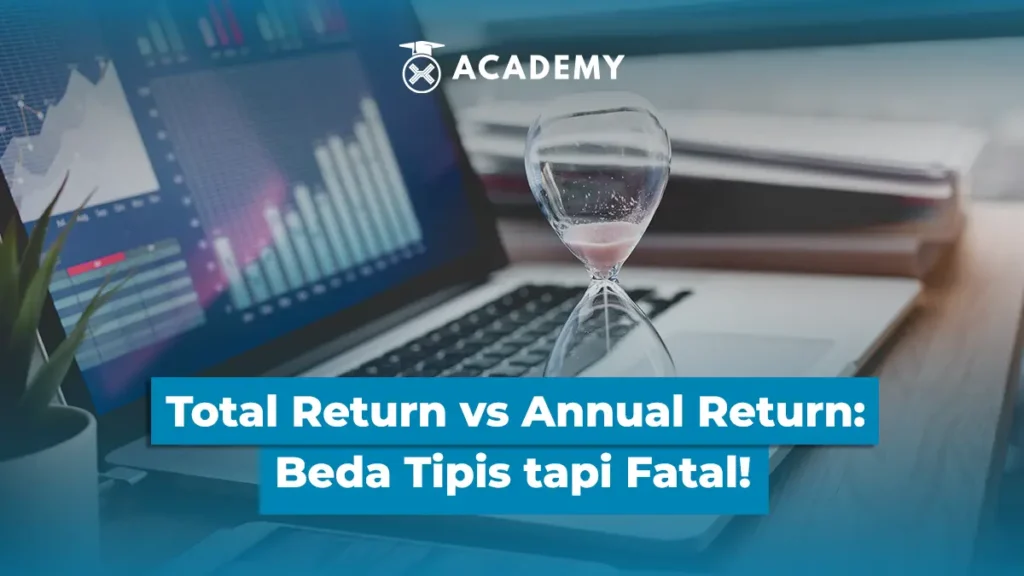Imagine two investors both earning a 50% return, but the final results could be very different because the calculation methods are not the same.
Mistakes like this are quite common, especially in the world of crypto investing, where many investors only pay attention to the total figure without understanding whether it refers to annual return or total return.
At first glance, they seem similar, but the difference between these two terms can cause your investment analysis to go seriously awry.
What is Total Return?

Total return is a measure that shows how much cumulative profit an investment has generated over a certain period.
This value includes two main components, namely capital gain/loss (increase or decrease in asset price) and additional income received from the investment, such as dividends, interest, or staking rewards.
In other words, total return describes the overall growth of the investment value from the beginning to the end of the period without taking into account the length of time the investment was made.
Basic formula:
Total Return = (Final Value – Initial Value) / Initial Value × 100%
For example, if you bought a crypto asset for $10,000, and its value increased to $15,000 a year later, the calculation would be:
Total Return = (15,000,000 – 10,000,000) / 10,000,000 × 100% = 50%
This means that during that one-year period, the value of your investment increased by 50%.
However, it is important to understand that total return does not take into account the annual duration or the effect of compound interest.
So, even though it appears to generate large profits, this figure does not necessarily indicate the efficiency of investment growth from year to year.
If you want to know the performance of your investment per year, rather than the cumulative total, you need another metric.
Key Comparison: Total Return vs. Annual Return
Simply put, the difference between total return and annual return lies in how they describe investment results.
Total return shows the cumulative profit over the entire investment period, without taking into account how long it took to achieve it.
Meanwhile, annual return shows the annualized results. This means that the profit is averaged per year by taking into account the effect of compound interest.
In terms of formula, total return is calculated using the following formula: Total Return = (End – Start) / Start. Meanwhile, annual return uses this formula: Annual Return = Annual Return = (End / Start) to the power of (1 ÷ years) ? 1.
This difference makes total return easier to calculate and quicker to understand, but less accurate for comparing the performance of investments with different durations.
Conversely, annual return requires slightly more complex calculations, but the results are more relevant for assessing the efficiency of investment growth in the long term.
In short, total return is like looking at the final result of an investment, while annual return describes the “averaged” result per year so that you can understand how effectively the investment has grown over time.
Case Study: Bitcoin Returns in 3 Years
Imagine you bought Bitcoin in January 2022 for Rp 400,000,000, then sold it three years later, in January 2025, when the price had reached Rp 800,000,000.
Simply put, this investment appears to have doubled your initial capital, resulting in a total return of 100%. This means that over three years, you earned a profit of Rp 400,000,000 on an initial capital of Rp 400,000,000.
However, if we look at the annual return, the result is not that large. Based on annual calculations, the average growth of this investment is around 26% per year.
This value illustrates how much the average increase occurs consistently each year, as if Bitcoin’s price growth is stable from year to year.
This is where many investors often misunderstand. A 100% total return figure looks impressive, but it doesn’t reflect the speed of growth or the time efficiency of the investment.
Conversely, annual returns provide a more realistic picture of investment performance over a specific period because they take into account time factors and the effects of compounding.
Understanding this difference allows you to more accurately assess investment potential, especially when comparing assets with different investment periods, such as crypto, stocks, or mutual funds.
This is why professional investors always use annual returns for long-term performance analysis.
When to Use Each
Understanding when to use total return and annual return is crucial so you can accurately assess investment results according to your goals and time frame.
Use total return when you want to know the total profit earned from an investment from the beginning to the end of a specific period.
This metric provides a comprehensive overview of how much your capital has grown without breaking it down into annual periods.
This approach is particularly useful for short-term analysis, such as when trading over a period of months or a year, where the primary focus is on seeing the difference between the asset’s initial and final value.
For example, if you buy a crypto token and sell it six months later at a higher price, the total return can directly show the percentage gain without having to consider the length of the investment period.
Conversely, use annual return when you want to compare performance between assets with different investment periods.
For example, when comparing a three-year Bitcoin investment with a five-year stock investment, the annual return is more fair because it takes into account time factors and the effects of compounding.
Furthermore, annual returns are also a good choice for evaluating long-term investment strategies, such as crypto staking, dollar-cost averaging (DCA), or HODL, where asset value growth occurs gradually.
With annual returns, you can see how efficiently an investment generates returns each year, not just the total return at the end of the period.
By understanding the context in which it’s used, you can avoid misjudging portfolio performance.
Common Investor Mistakes
Mistakes investors often make are often misinterpreted numbers. For example, many people think a 50% total return in 3 years means a 50% return per year, when in fact, it’s simply cumulative growth over that period.
Another mistake is comparing investments with different durations using the same metric, which can be misleading. It also ignores the effects of time or compounding, which can lead to inaccurate analysis.
Therefore, as a tip, always check the formula because if it doesn’t have a power of 1/n, it’s not an annual return.
The Importance of Understanding Context in Crypto

In a highly volatile market like crypto, extreme price movements can make total returns appear misleading.
For example, an asset may experience a significant surge in one year, but its performance may fluctuate in subsequent years. If investors only look at total returns, they may misjudge the risk and potential returns of their investment.
Therefore, annual returns are a more ideal metric for evaluating the long-term performance of crypto assets like Bitcoin, Ethereum, Solana, and others.
Annual returns take into account investment duration and the effects of compounding, providing a more realistic picture of the asset’s annual growth.
This is also related to investor behavior in the crypto market. Many experience FOMO (fear of missing out) when they see high total returns.
However, these figures are only the accumulated results of several years and do not reflect the actual annual performance. By understanding this context, investors can make more informed decisions and reduce the risk of misperceptions.
Conclusion – One Number Can Lead to Wrong Decisions
So, that was an interesting discussion about Total Return vs. Annual Return: A Small but Fatal Difference! which you can read in full at the INDODAX Academy Crypto Academy.
In conclusion, total return shows the cumulative results of an investment over a specific period, without considering the length of time or the effects of compounding.
Meanwhile, annual return describes the average return per year, providing a more realistic picture of how efficiently an investment grows each year.
Both are equally important, but their use must be adjusted to the context of the analysis. Ignoring this difference can lead investors to misjudge portfolio performance or make poor decisions.
Ultimately, a smart investor isn’t one who chases the highest returns, but one who understands the meaning behind the numbers.
By the way, in addition to gaining in-depth insights through various popular crypto education articles, you can also broaden your horizons through a collection of tutorials and choose from a variety of popular articles that suit your interests.
Besides updating your knowledge, you can also directly monitor digital asset prices on Indodax Market and stay up-to-date with the latest crypto news. For a more personalized trading experience, explore Indodax’s OTC trading service. Don’t forget to activate notifications so you don’t miss out on important information about blockchain, crypto assets, and other trading opportunities.
You can also follow our latest news via Google News for faster and more reliable access to information. For an easy and secure trading experience, download the best crypto app from INDODAX on the App Store or Google Play Store.
Maximize your crypto assets with the INDODAX Earn feature, a practical way to earn passive income from your stored assets. Register now with INDODAX and easily complete KYC to start trading crypto more safely, conveniently, and reliably!
Indodax Official Contact
Customer Service Number: (021) 5065 8888 | Support Email: [email protected]
Also follow us on social media here: Instagram, X, Youtube & Telegram
FAQ
1.What is the difference between total return and annual return?
Total return is the cumulative return on an investment, while annual return is the annualized average.
2.Can total return be higher than annual return?
Yes, because total return covers the entire period, not the annual return.
3.How do you calculate annual return from total return?
Use the formula: (1 + total return)^(1/number of years) – 1.
4.Which is more important for crypto investors?
Annual return, because it takes into account the effects of time and is fairer for comparing assets.
5.Why can the difference between these two terms be fatal?
Because misreading metrics can lead investors to misjudge asset performance and make poor investment decisions.
Author: Boy






 Polkadot 9.23%
Polkadot 9.23%
 BNB 0.57%
BNB 0.57%
 Solana 4.89%
Solana 4.89%
 Ethereum 2.37%
Ethereum 2.37%
 Cardano 1.22%
Cardano 1.22%
 Polygon Ecosystem Token 2.17%
Polygon Ecosystem Token 2.17%
 Tron 2.83%
Tron 2.83%
 Market
Market


